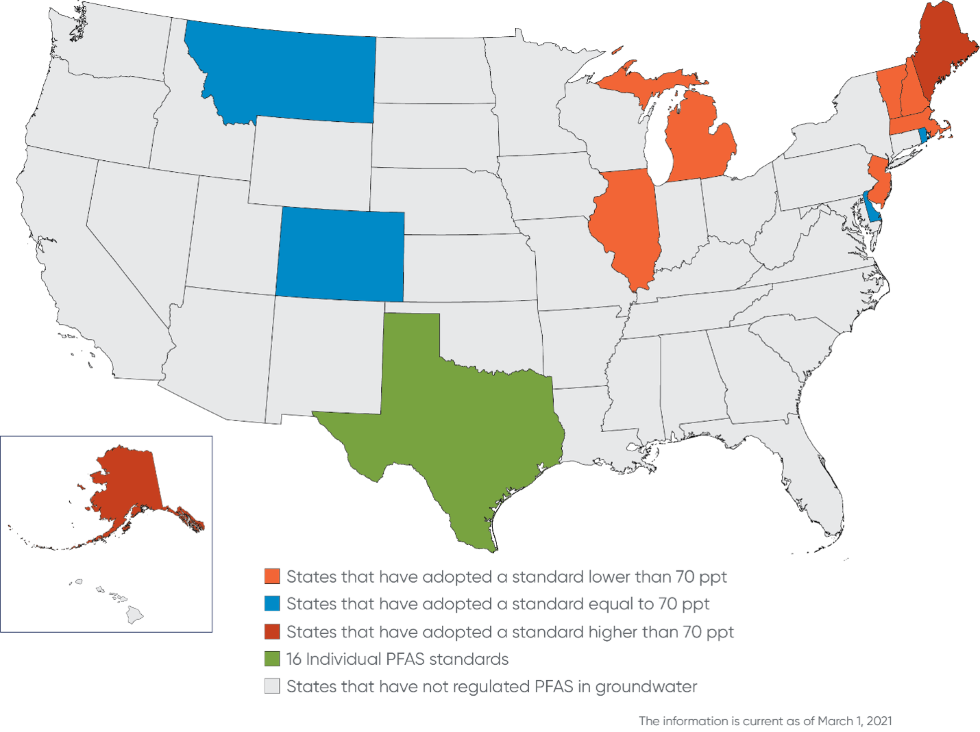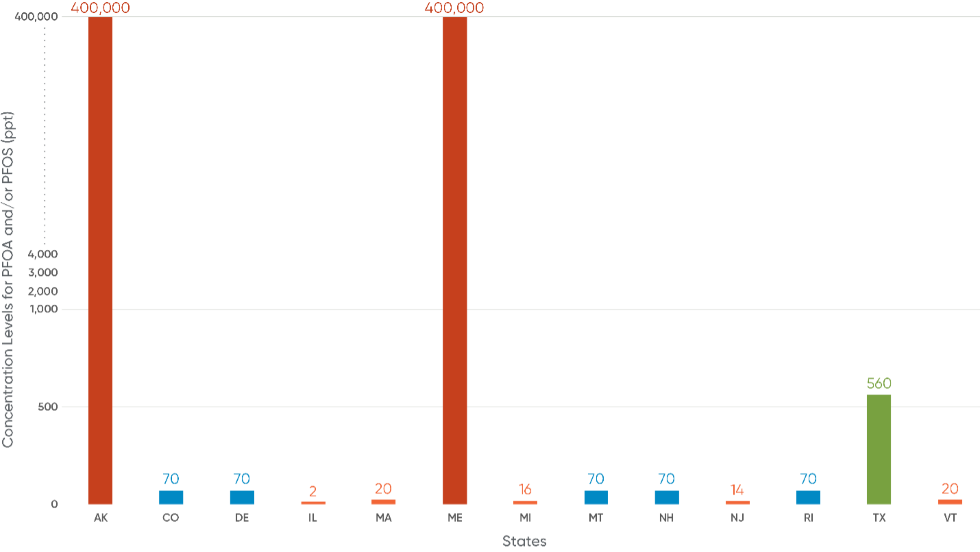BCLPemerging.com
PFAS Update: Current State-by-State Groundwater Regulations
Feb 26, 2021This blog was originally published in February 2021. Visit our up-to-date blog on PFAS in groundwater: state-by-state regulations >
Many states have expressed frustration with the lack of federal cleanup standards for per- and polyfluoroalkyl substances (“PFAS”) in groundwater, and have started the process of regulating PFAS in groundwater themselves. As a result, states have adopted a patchwork of regulations and guidance standards that present significant challenges to impacted industries. This client alert focuses on the different state regulations regarding the guidance, notification, and cleanup levels for PFAS – typically perfluorooctanesulfonic acid (“PFOS”) and perfluorooctanoic acid (”PFOA”) – in groundwater.
State Regulations
The snapshot provided below is current as of March 1, 2021, but it is important to note that this is a rapidly developing regulatory space. Some states, such as North Carolina, Pennsylvania, Rhode Island, and Wisconsin have proposed groundwater regulations for PFAS which may take effect later this year, and more state actions, as well as possible federal action, are expected to be announced this year. All of which means that if your business is assessing your current risk, or conducting due diligence on a property, and there is the possibility of ongoing or legacy PFAS use or contamination, please feel free to contact us to discuss the most recent regulations in the applicable jurisdiction(s).
| Illinois | 2 ppt (stated by the Illinois Pollution Control Agency as 2 ng/L) | PFOA (Guidance) | Regulation (still in draft form) and Related Information | |
| Michigan | 6 ppt | PFNA (Clean Up) | Regulation and Related Information | |
| Michigan | 8 ppt | PFOA (Clean Up) | Regulation and Related Information | |
| New Hampshire | 11 ppt | PFNA (Clean Up) | Regulation and Related Information | |
| New Hampshire | 12 ppt | PFOA (Clean Up) | Regulation and Related Information | |
| New Jersey | 13 ppt | PFNA and PFOS (Clean Up) | Regulation and Related Information | |
| New Jersey | 14 ppt | PFOA (Clean Up) | Regulation and Related Information | |
| New Hampshire | 15 ppt | PFOS (Clean Up) | Regulation and Related Information | |
| Michigan | 16 ppt | PFOS (Clean Up) | Regulation and Related Information | |
| New Hampshire | 18 ppt | PFHxS (Clean Up) | Regulation and Related Information | |
| Massachusetts | 20 ppt (Stated in the regulation as .02 ppb) | 6 PFAS Substances combined -- PFOA, PFOS, PFHxS, PFNA, PFHpA, and PFDA (Clean Up) | Regulation and Related Information | |
| Vermont | 20 ppt (Stated in the regulation as .02 µg/L) | 5 PFAS substances combined: PFHpA, PFHxS, PFNA, PFOS and PFOA (Notification) | Regulation and Related Information | |
| Michigan | 51 ppt | PFHxS (Clean Up) | Regulation and Related Information | |
| Colorado | 70 ppt | Site-specific Standards for PFOA and PFOS (Clean Up) | Site-Specific Groundwater Quality Standard | |
| Delaware, Montana, and Rhode Island | 70 ppt | Follow the EPA Health Advisory Level: PFOS and PFOA combined (Guidance and Notification) | Delaware: Guidance Policy
Montana: Guidance Standard Rhode Island: Notification Standard
|
|
| Illinois | 140 ppt (stated by the Illinois Pollution Control Agency as 140 ng/L) | PFHxS (Guidance) | Regulation (still in draft form) and Related Information | |
| Texas | 290 ppt, etc. | 16 Different PFAS Substances (Clean Up) | Protective Concentration Levels | |
| Michigan | 370 pp | HFPO-DA (Clean Up) | Regulation and Related Information | |
| Michigan | 420 ppt | PFBS (Clean Up) | Regulation and Related Information | |
| Illinois | 140,000 ppt (stated by the Illinois Pollution Control Agency as 140,000 ng/L) | PFBS (Guidance) | Regulation (still in draft form) and Related Information | |
| Michigan | 400,000 ppt | PFHxA (Clean Up) | Regulation and Related Information | |
| Alaska | 400,000 ppt (Stated in the regulation as .4 µg/L) | PFOA and PFOS separately (Clean Up) | Regulation (18 AAC 25) and Related Information | |
| Maine | 400,000 ppt (Stated in the regulation as .4 ppb) | PFOA and PFOS separately (Guidance)
Note: Maine has both residential and construction standards
|
Maximum Exposure Guideline | |
| Illinois | 560,000 ppt (stated by the Illinois Pollution Control Agency as 560,000 ng/L) | PFHxA (Guidance) | Regulation (still in draft form) and Related Information |

Additional Considerations
Without a federal PFAS standard, the various states have enacted a wide range of regulations, notifications, or advisories. For example, for PFAS substances in groundwater, the smallest concentration is 2 ppt (Illinois; PFOA only) and the largest value is 560,000 ppt (Illinois; PFHxA only). For consistency, the following chart illustrates the discrepancies in the concentration levels only for PFOA and/or PFOS.

Conclusion
Businesses operating in these 13 states should consider whether they currently use or discharge any of the regulated PFAS compounds. In addition, owners of property with legacy PFAS use, and prospective purchasers of commercial and industrial properties, should use the groundwater quality standards as part of their due diligence processes.
For more information on PFAS chemicals, and the regulatory and litigation risks that they pose, please visit our PFAS webpage. If you have a question about how to manage PFAS risk in any jurisdiction, contact Tom Lee, John Kindschuh, or any other member of our PFAS team at Bryan Cave Leighton Paisner LLP.




